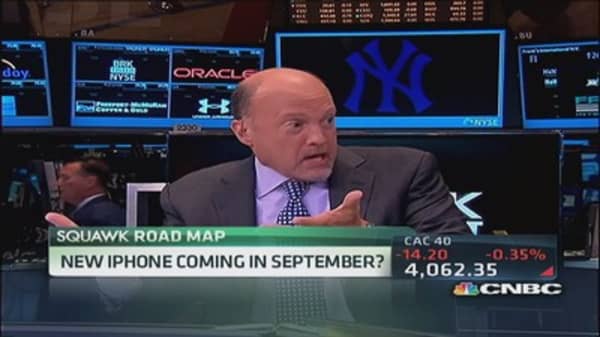Samsung's latest phone, the Galaxy Mega, is the latest example of trying to stand out. The smartphone, which launches Friday on AT&T for $150, measures 6.3 inches diagonally, making it almost as big as a 7-inch tablet.
(Read more: New 6.3-inch Samsung phone approaches tablet size)
Samsung says that the new Mega is meant to work as a hybrid between a phone and a tablet so that consumers don't have to buy two products. However, the size of the phone may be more of a joke to consumers instead of a practical device.
"It's becoming a little silly," said Carolina Milanesi, a vice president of research on Gartner's consumer devices team. "It seems to me these companies are doing it just for sake of doing it."
Huawei rolled out its 6.1-inch Ascend Mate smartphone earlier this year, so Samsung had to play catch-up to that, she said.
"Five inches use to be the best size and then 5 inch became the norm and so companies felt like they needed to go up, and if you do 5.5-inch screen, people are going to catch up to you very quickly. So they jumped to the 6 inches," she said.
But with the phones entering the 6-inch range, the line between phone and tablet becomes blurred. Vendors, though, argue the large size solves the problem of having to carry two different devices—a tablet and a smartphone—at the same time.
And while this may be a solution for some consumers, it's really not a problem most people have.
While there is a growing number of tablet users, most of them only use their tablet at home, Milanesi said. In addition, most people still a want something they can fit in their pocket while they're on the go, which is why she said she doesn't see these extra large smartphones having mass appeal.
"I've always been a skeptic about very large screen smartphones," Milanesi said. "As much as you want people thinking they are getting one device with everything, it's still not quite practical. And as prices on 7-inch tablets continue to [get] lower, you will have more consumers who can afford both so they will buy both."
But there is definitely a market for the large-screen phones, said Charles Golvin, a principal analyst at Forrester Research. While the sweet spot for a smartphone size remains 4-5 inches, there's a segmented group of consumers who will prefer a bigger device, he said.
"You can't just have a one size fits all. Now people have a lot more choice, they have a lot more experience, they know what they like, and what they don't like. For some people, bigger is better; they like the bigger screen," Golvin said. "They are definitely not mainstream; most people want something that is more pocketable than that. ... [But] they are still selling."
While Samsung is going big, HTC is going smaller. The HTC One Mini, which also launches Friday on AT&T for $99.99 with a two-year contract, features a 4.3-inch screen, making it slightly smaller than the full size version's 4.7 inches.
However, while the Mini may be smaller than some of its competitors, it's still about the same size as an iPhone 5, which has a 4-inch display screen.
"When the HTC Mini was announced, it made me smile to see something that's 4.3-inches considered a mini, 2.6-inch was once considered a mini," Milanesi said. "If you go back a few years ago, Ericsson had a 2.6-inch mini. It was incredibly small. We haven't had 2.6-inch screen for years now, and now 4.3-inch is not that small."







